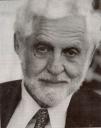[I wrote this in 1999.]
Stanford chemistry Professor Dr. Carl Djerassi is often called the “father of the birth control pill.”
In 1951, the brilliant young organic chemist made history by synthesizing the first steroid effective as an oral contraceptive at Syntex’s Mexico City lab. This breakthrough led to the development of the birth control pill, which ranks near the top on the list of 20th century scientific achievements.
The glow of worldwide recognition might have enough for some, but not for the prolific Djerassi. He exchanged his white lab coat for highly successful careers in academia and as an industrial executive in Palo Alto.
He founded the Djerassi Resident Artist Program: by 1999 more than 1000 musicians, painters and writers have used its studios near rustic Woodside.
Most recently, Djerassi has plunged into the literary world as the engaging author of what he calls “science-in-fiction” novels and as a playwright whose latest work, “The Immaculate Misconception,” was performed at the Eureka Theater in San Francisco.
Djerassi was born in Vienna in 1923, the only child of Jewish parents, both physicians. The relationship with his parents was complex. In Djerassi’s 1992 scientific autobiography, “The Pill, Pygmy Chimps, and Degas’ Horse, he confesses that he did not know until he was 13 that his mother and father divorced when he six.
On the brink of World War II, in 1939, Djerassi and his mother fled Europe for the United States. First residing on the East Coast, the highly driven young man, almost penniless, went after and got a formal education in record time.
He was only 18 when he received a chemistry degree from Kenyon College in Ohio in 1942. Djerassi gained industrial experience working for a year at CIBA Pharmaceuticals in New Jersey, participating in the discovery of one of the first anti-histamines for allergy sufferers–an experience exposing him to the heady stuff of scientific research.
Djerassi earned his doctorate at the University of Wisconsin in 1945, where two young professors were researching the total synthesis of steroids, such as cortisone, then believed to be a wonder drug containing anti-arthritic properties. Djerassi’s interest in steroids was most likely further stimulated here.
Returning to CIBA, Djerassi felt restless and needed a new challenge.
The opportunity appeared in the late 1940s as he considering heading a research team at tiny Syntex in Mexico City. He had never heard of Syntex, and friends warned him that Mexico City was a scientific backwater.
Viewing Syntex as the longed-for challenge, he accepted the post, requiring only that he be free to publish his discoveries promptly in scientific journals.
It was a good decision. The unknown firm entered into a fierce competition with the big pharmaceutical houses racing to inexpensively synthesize cortisone. Syntex defeated the Goliaths with a readily available plant, the mundane
Djerassi and his team moved onto a greater project. On October 1, 1951, the first steroid oral contraceptive was synthesized. Following animal testing and human clinical trials, it was immortalized as “the pill.”
Djerassi did not spend much time celebrating: a year later, he accepted a teaching position at Wayne University in Michigan. Again, friends advised him it was wrong, the position not prestigious enough. Always single-minded, Djerassi wanted to taste academic life and accepted the offer while retaining his relationship with Syntex.
In the late 1950s, Frederick Terman, Stanford’s provost, legendary for creating Stanford Industrial Park, decided to develop a world-class chemistry department at the university. Djerassi was on the list.
He described the meeting with Terman in his autobiography. Some critics considered Djerassi a “bigamist” for his split loyalties to the university and the corporate world. Not Terman. He was delighted with Djerassi’s Syntex affiliation.
Djerassi was one of seven pre-eminent professors hired, some of them Nobel Prize winners. Shortly thereafter, Djerassi, who eventually became president of Syntex, persuaded the company to move its headquarters to Palo Alto.
In the 1970s Djerassi headed Zoecon, an offshoot of Syntex, a tiny Palo Alto company that sought to produce superior insecticides from a growth-regulating hormone naturally present in insects. When the Environmental Protection Agency (EPA) permitted Zoecon to begin limited marketing of ALTOSID, it was the first time a regulatory agency allowed the sale of a product that interfered with an insect’s own physiology. Once again Djerassi was at the forefront of a scientific breakthrough.
Juggling professorial duties with that of an industrial executive, Carl Djerassi was the only chemistry professor to hold classes at 8 a.m. He spent the noon hours at Zoecon, eating lunch prepared by the company’s chef in his office to save time.
When the Swiss firm, Sandoz, acquired Zoecon in the 1980s, the headquarters wasz moved away from Palo Alto.
Djerassi’s wife, Diane Wood Middlebrook, passed away in 2007. She was a poet and Stanford English professor, the author of a highly acclaimed biography about Anne Sexton, the famous American “confessional” poet.
Thus it was inevitable that Carl Djerassi would try his hand in the world of literature. He began writing poetry and expanded into prose with what he calls “science-in-fiction” novels, including “Cantor’s Dilemma,” Menachem’s Seed” and NO.”
In 1999 Djerassi wans spending 60 to 80 hours per week writing, fashioning his work for the stage, including a new play called “Oxygen.” Djerassi’s son, Dale, is an accomplished filmmaker and the two were collaborating on a project.

